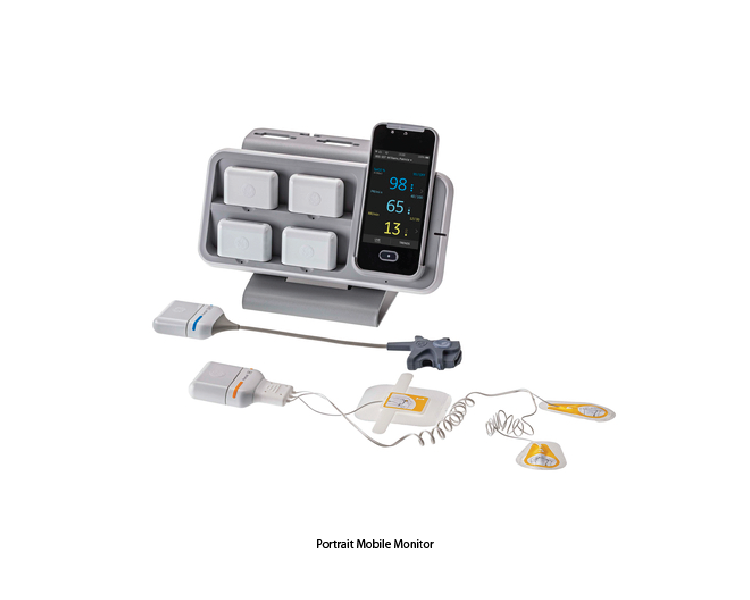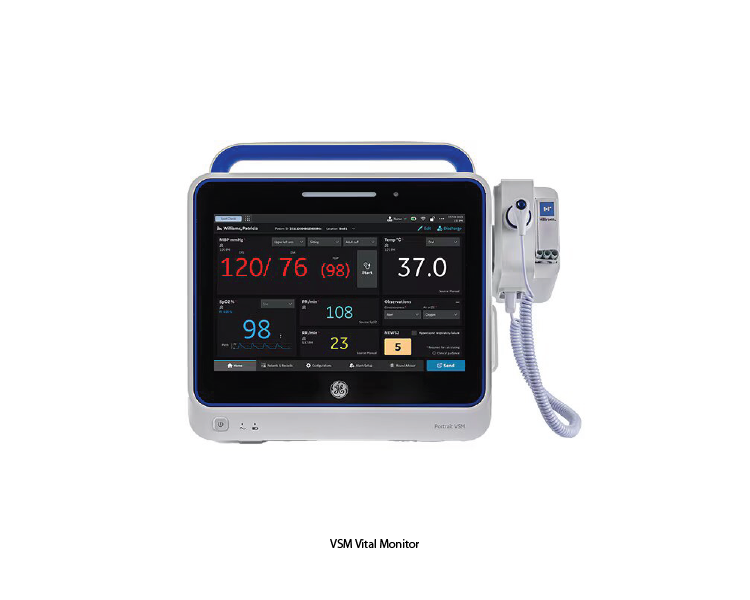Portrait™ Mobile Monitor
The Portrait™ Mobile Monitor is part of GE Healthcare's portfolio of patient monitoring solutions, designed to meet the evolving needs of healthcare providers for portable and adaptable monitoring systems. It combines advanced monitoring capabilities with ease of use and mobility, making it suitable for use in diverse clinical environments, from hospitals and intensive care units to outpatient clinics and transport settings.
Key Features of Portrait™ Mobile Monitor
1. Comprehensive Monitoring Capabilities:
• Multi-Parameter Monitoring: Offers continuous monitoring of vital signs and physiological parameters, including ECG, heart rate, blood pressure, SpO2, and respiratory rate.
• Customizable Alarms: Provides customizable alarm settings to alert healthcare providers to deviations from preset thresholds, ensuring timely interventions.
2. Portable and Lightweight Design:
• Mobility: Designed for portability, allowing easy transport between different patient care areas and during patient transfers.
• Compact Form Factor: Features a lightweight and compact design for maneuverability and space efficiency in clinical settings.
3. Intuitive User Interface:
• Touchscreen Display: Features an intuitive touchscreen interface with clear and easy-to-read graphical displays of vital sign parameters.
• Simple Navigation: Allows for easy navigation of menus and settings, enabling quick access to monitoring functions.
4. Flexible Power Options:
• Battery Operation: Equipped with a rechargeable battery for continuous monitoring even during power outages or when access to electrical outlets is limited.
• AC Power: Supports AC power for charging and extended monitoring sessions in stationary settings.
5. Data Connectivity and Integration:
• Data Transfer: Offers options for data transfer and connectivity, allowing seamless integration with hospital networks and electronic medical record (EMR) systems.
• Remote Monitoring: Enables remote monitoring capabilities, facilitating real-time access to patient data and remote consultation.
Clinical Applications of Portrait™ Mobile Monitor
1. Inpatient Monitoring:• General Wards: Used for continuous monitoring of patients admitted to general medical and surgical wards, providing real-time assessment of patient status and trends.
• Critical Care Units: Provides advanced monitoring capabilities for critically ill patients in intensive care units (ICUs) and high-dependency units (HDUs), supporting early detection of deterioration and prompt interventions.
2. Emergency and Trauma Care:
• Emergency Departments: Facilitates rapid assessment and monitoring of patients presenting to the emergency department with acute illnesses, injuries, or trauma.
• Transport Monitoring: Used for monitoring patients during interfacility transfers, ambulance transport, and aeromedical evacuations, ensuring continuity of care during transport.
3. Perioperative Monitoring:
• Operating Rooms: Supports intraoperative monitoring of vital signs and physiological parameters during surgical procedures, aiding in anesthesia management and patient safety.
• Post-Anesthesia Care Units (PACUs): Monitors patients recovering from anesthesia and surgical procedures, assisting in postoperative care and early detection of complications.
4. Telemetry and Remote Monitoring:
• Telemetry Units: Provides telemetry monitoring capabilities for patients requiring continuous cardiac monitoring outside traditional clinical settings.
• Home Healthcare: Supports remote monitoring of patients receiving home healthcare services, enabling virtual patient monitoring and telehealth consultations.
VSM Vital Signs Monitor
VSM Vital Signs monitoring is a widely used system that provides continuous and automated measurement of vital signs, including blood pressure, pulse rate, temperature, and oxygen saturation (SpO2). It is designed to be user-friendly, reliable, and accurate, making it suitable for various healthcare environments, from hospitals to outpatient clinics.
Key Features of VSM Vital Signs
1. Non-Invasive Measurements:
• Automated Monitoring: Offers non-invasive and continuous monitoring of vital signs, reducing the need for repeated manual measurements.
• Patient Comfort: Minimizes patient discomfort and anxiety associated with invasive procedures, such as arterial catheterization for blood pressure monitoring.
2. Integrated Sensors:
• Multi-Parameter Monitoring: Integrates sensors for measuring blood pressure, pulse rate, temperature, and SpO2 in a single device, providing comprehensive patient monitoring.
• Advanced Technology: Utilizes advanced sensors and algorithms to ensure accurate and reliable measurements across different physiological parameters.
3. User-Friendly Interface:
• Intuitive Display: Features an easy-to-read display with clear indicators and alarm settings for quick interpretation of vital signs.
• Touchscreen Controls: Some models may incorporate touchscreen controls for easy navigation and customization of monitoring parameters.
4. Customizable Settings:
• Flexible Configurations: Allows healthcare providers to customize monitoring settings based on individual patient needs and clinical requirements.
• Alarm Management: Enables adjustment of alarm thresholds and settings to alert healthcare staff of abnormal vital sign readings or changes in patient condition.
5. Data Management:
• Electronic Documentation: Facilitates electronic documentation of vital sign measurements, allowing for seamless integration with electronic health records (EHR) systems.
• Trend Analysis: Provides graphical representation and trend analysis of vital sign data over time, supporting clinical decision-making and patient management.
Clinical Applications of VSM Vital Signs
1. Inpatient Monitoring:• General Wards: Used for routine vital signs monitoring of patients admitted to general medical and surgical wards, enabling early detection of changes in patient condition.
• Critical Care Units: Provides continuous monitoring of critically ill patients in intensive care units (ICUs) and high-dependency units (HDUs), supporting timely interventions and management of unstable patients.
2. Outpatient Settings:
• Ambulatory Clinics: Enables non-invasive monitoring of vital signs in outpatient clinics and primary care settings, facilitating the assessment of patients with chronic conditions or during routine check-ups.
• Specialty Clinics: Used in specialty clinics such as cardiology, pulmonology, and nephrology for monitoring patients undergoing diagnostic procedures or receiving treatment.
3. Emergency Care:
• Emergency Departments: Provides rapid assessment and monitoring of vital signs in patients presenting to the emergency department with acute illnesses or injuries, aiding in triage and initial management.
• Trauma Centers: Used for continuous monitoring of trauma patients during resuscitation and stabilization, helping identify life-threatening conditions and prioritize interventions.
4. Perioperative Care:
• Operating Rooms: Facilitates intraoperative monitoring of vital signs during surgical procedures, ensuring patient safety and optimizing anesthesia management.
• Post-Anesthesia Care Units (PACUs): Continuously monitors patients recovering from anesthesia, assisting in early detection of postoperative complications and facilitating timely interventions.


